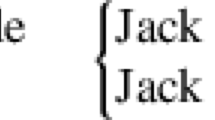Abstract
The morphological expression of gender on nouns displays a puzzling behaviour under ellipsis of nominal predicates. In some instances, it appears that gender can be ignored in the calculation of the identity/parallelism requirement. With other nouns, gender seems relevant and mismatch engenders parallelism violations. With yet a third group of nouns, there is an asymmetry—an overt masculine noun licenses ellipsis of the corresponding feminine, but not vice versa. The difference between the last two groups is exemplified by the English contrast in: John is a {waiter/#prince} and Mary is too (compare #Mary is a waitress/princess, and John is too). We examine six languages, and show that nouns for nobility/titles and kinship nouns form a systematic exception to an otherwise stable marked: unmarked opposition, and that when this class of nouns is factored out, the remaining two classes reflect the inflection/derivation distinction in the morphological realization of gender.
Similar content being viewed by others
References
Andrews A. (1990) Unification and morphological blocking. Natural Language and Linguistic Theory 8: 507–557
Bobaljik J.D. (2008) Where’s Phi? Agreement as a post-syntactic operation. In: Adger D., Béjar S., Harbour D. (eds) Phi-theory: Phi features across interfaces and modules. Oxford University Press, Oxford, pp 295–328
Cooper R. (1983) Quantification and syntactic theory. Reidel, Dordrecht
Comrie, B., & Stone. G. (1978). The Russian language since the revolution. Oxford University Press.
Corbett G. (1991) Gender. Cambridge University Press, Cambridge
Corbett G. (2007) Canonical typology, suppletion and possible words. Language 83: 8–42
Greenberg, J. (eds) (1963) Universals of language. MIT Press, Cambridge, MA
Greenberg J. (1966) Language universals, with special reference to feature hierarchies. Mouton & Co, The Hague
Haspelmath M. (2006) Against markedness (and what to replace it with). Journal of Linguistics 42(1): 25–70
Heim I. (1991) Artikel und Definitheit. In: Stechow A., Wunderlich D. (eds) Semantik: Ein internationales Handbuch der zeitgenöschen Forschung. de Gruyter, Berlin, pp 487–535
Heim I. (2008) Features on bound pronouns. In: Adger D., Harbour D., Bejar S. (eds) Phi theory: Phi-features across modules and interfaces. Oxford University Press, Oxford, pp 35–52
Jakobson, R. (1984). Structure of the Russian verb. In L. R. Waugh & M. Halle (Eds.), Russian and Slavic Grammar—Studies 1931–1981. Berlin: Mounton de Gruyter. (Translation of ‘‘Zur Struktur des russischen Verbums” in Charisteria Gvilelmo Mathesio qvinqvagenario a discipulis et Circuli Lingvistici Pragensis sodalibus oblata, Prague, 1932.)
Kornfeld L., Saab A. (2004) Nominal ellipsis and morphological structure in Spanish. In: Bok-Bennema R., Hollebrandse B., Kampers-Manhe B., Sleeman P. (eds) Romance languages and linguistic theory 2002. John Benjamins, Amsterdam, p 183
Kratzer A. (1998) More structural analogies between pronouns and tenses. In: Strolovitch D., Lawson A. (eds) Proceedings of SALT VIII. Cornell Linguistics Circle, Ithaca
Kratzer A. (2009) Making a pronoun: Fake indexicals as windows into the properties of pronouns. Linguistic Inquiry. 40(2): 187–237
Lasnik H. (1995) Verbal morphology: Syntactic structures meets the Minimalist Program. In: Campos H., Kempchinsky P. (eds) Evolution and revolution in linguistic theory: Essays in honor of Carlos Otero. Georgetown University Press, Georgetown, pp 251–275
Lumsden J. (1992) Underspecification in grammatical and natural gender. Linguistic Inquiry 23: 469–486
Nunes, J. & Zocca, C. L. (2005). Morphological identity in ellipsis. In Leiden Working Papers in Linguistics 2.2 (pp. 29–42). Leiden: Leiden University.
Osthoff H. (1899) Vom Suppletivwesen der indogermanischen Sprachen. Kommissionsverlag von Alfred Wolff, Heidelberg
Percus, O. (this volume). Gender features and interpretation: A case study.
Pollard C., Sag I. (1994) Head-driven phrase structure grammar. University of Chicago Press, Chicago
Rothstein R. (1973) Sex, gender, and the October Revolution. In: Anderson S., Kiparsky P. (eds) A Festschrift for Morris Halle. Holt Rinehart and Winston, New York, pp 460–466
Sauerland U. (2008) Implicated presuppositions. In: Steube A. (eds) Sentence and context, language, context and cognition. Mouton de Gruyter, Berlin
Schlenker, P. (1999). Propositional attitudes and indexicality (A cross-categorial approach). PhD Dissertation, MIT.
Spathas, G. (2008). On the interpretation of gender on nouns and pronouns. Ms., UiL-OTS, Utrecht.
Spencer A. (2002) Gender as an inflectional category. Journal of Linguistics 38: 279–312
Stjepanović, S. (1997). VP ellipsis in a verb-raising language. In A. Jennifer & A. Lawson (Eds.), Proceedings of ESCOL 1997. Cornell University, Ithaca: CLC Publications.
Author information
Authors and Affiliations
Corresponding author
Rights and permissions
About this article
Cite this article
Bobaljik, J.D., Zocca, C.L. Gender markedness: the anatomy of a counter-example. Morphology 21, 141–166 (2011). https://doi.org/10.1007/s11525-010-9156-3
Received:
Accepted:
Published:
Issue Date:
DOI: https://doi.org/10.1007/s11525-010-9156-3




